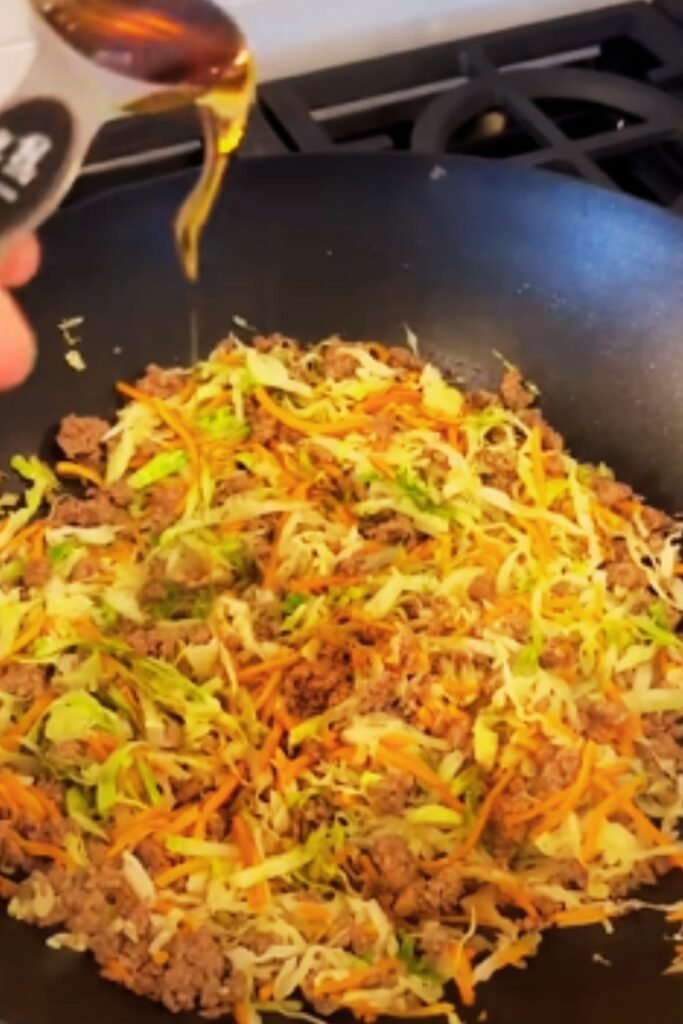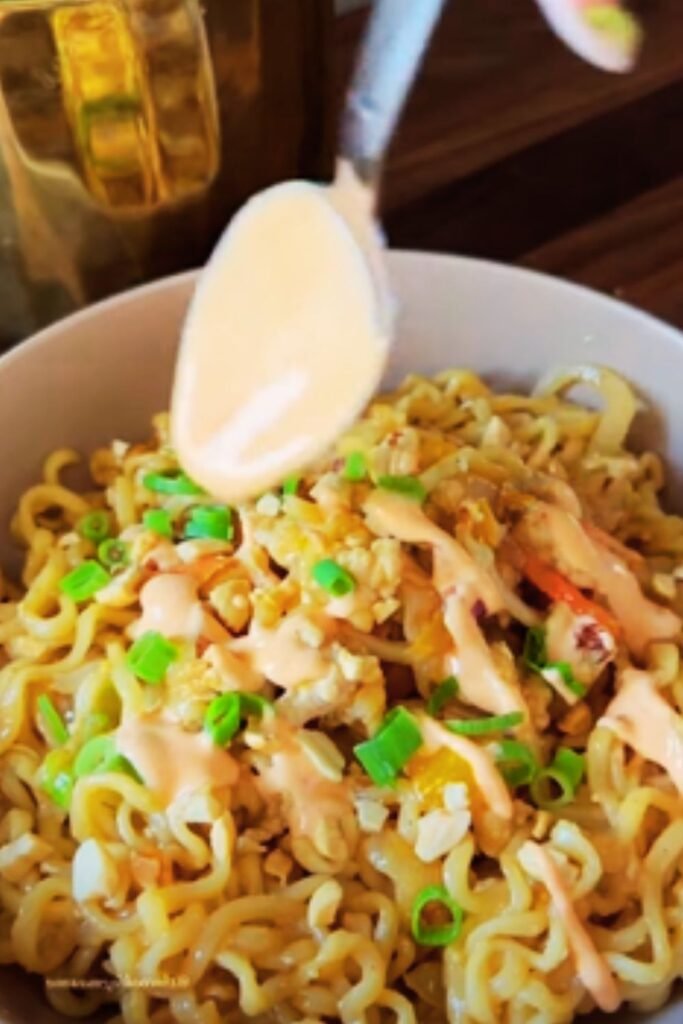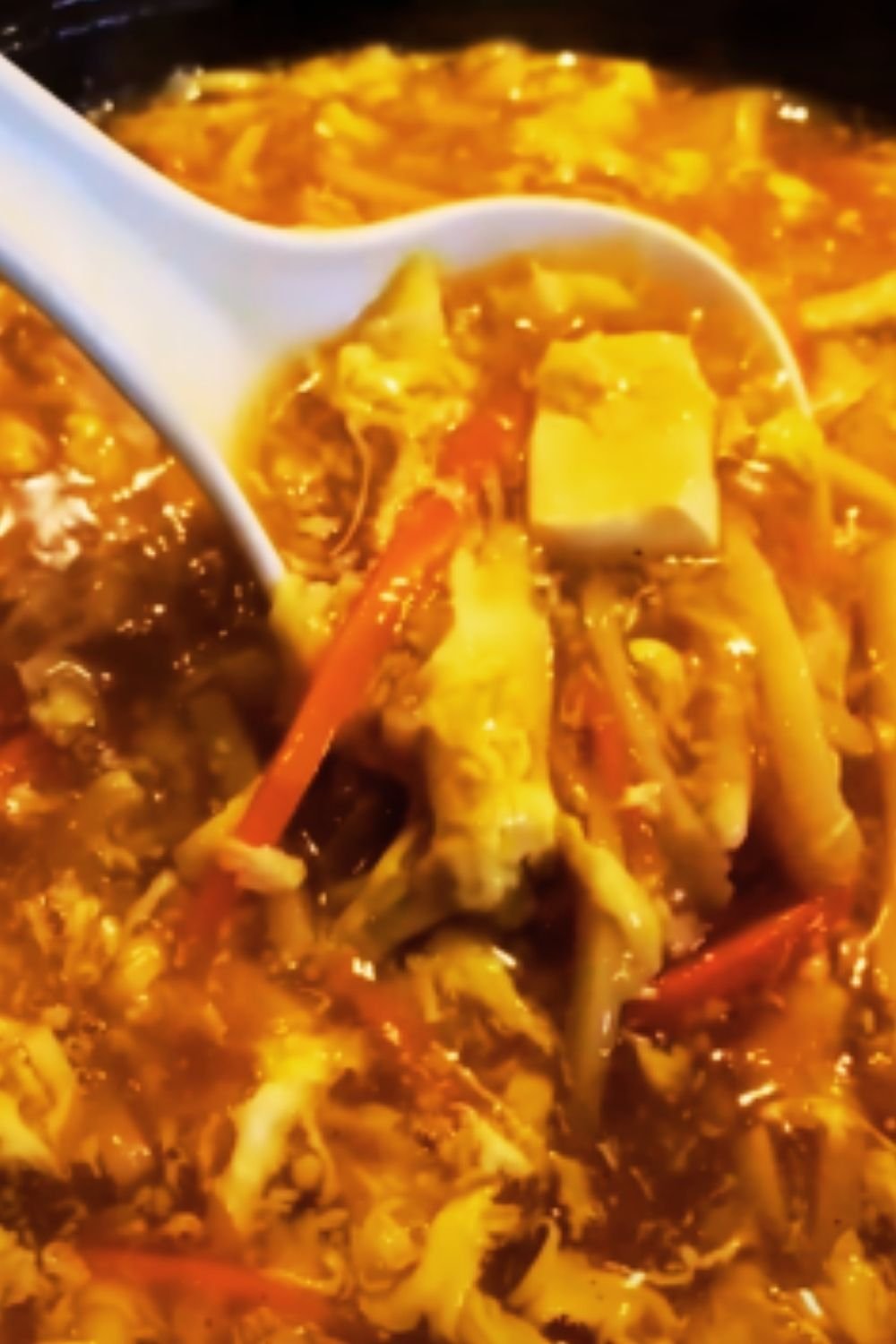Have you ever found yourself craving both Chinese takeout and a comforting bowl of ramen at the same time? I know I have! That’s exactly how this Egg Roll Ramen Skillet recipe was born in my kitchen. By combining the savory filling of traditional egg rolls with the convenience and comfort of ramen noodles, I’ve created a one-pan wonder that delivers big on flavor while saving time on cleanup.
In this article, I’ll walk you through how to create this fusion masterpiece that has quickly become a favorite in my household. Trust me when I say this dish hits all the right notes – it’s savory, satisfying, and surprisingly simple to make!
The Story Behind This Fusion Creation
I still remember the night I created this dish. I had a package of ground pork that needed to be used, a half head of cabbage sitting in the refrigerator, and a serious craving for something that would satisfy my takeout cravings without having to place an order. As I rummaged through my pantry, I spotted a few packets of ramen noodles.
The lightbulb moment hit me – why not combine the filling of an egg roll with the simplicity of ramen? That evening, my Egg Roll Ramen Skillet was born, and it’s been a regular in my dinner rotation ever since.
What makes this dish special is how it transforms humble ingredients into something extraordinary. The familiar flavors of egg roll filling pair surprisingly well with ramen noodles, creating a meal that feels both innovative and nostalgic at the same time.
Ingredients You’ll Need
Before we dive into the cooking process, let’s gather our ingredients. What I love about this recipe is that it relies mostly on pantry staples and long-lasting produce:
- 1 pound ground pork (can substitute ground chicken or turkey)
- 3 packages instant ramen noodles (discard the seasoning packets)
- 1 small head of cabbage (about 4 cups shredded)
- 2 medium carrots, julienned or grated
- 1 large onion, thinly sliced
- 3 cloves garlic, minced
- 1 tablespoon fresh ginger, grated
- 4 green onions, sliced (white and green parts separated)
- 2 tablespoons neutral oil (like vegetable or canola)
- 2 tablespoons sesame oil, divided
- ¼ cup soy sauce (low sodium preferred)
- 2 tablespoons rice vinegar
- 1 tablespoon hoisin sauce
- 1 tablespoon sriracha (adjust to taste)
- 2 cups chicken broth
- Optional garnishes: toasted sesame seeds, cilantro, extra sriracha

Kitchen Equipment Needed
This is truly a one-skillet meal, but you’ll need a few tools to make the process smooth:
- Large skillet or wok (12-inch minimum)
- Cutting board
- Sharp knife
- Measuring cups and spoons
- Wooden spoon or spatula
- Tongs (helpful for tossing the noodles)
Preparation: The Key to Success
I’ve found that the secret to making this dish come together quickly is preparation. Take about 15 minutes before you start cooking to:
- Shred the cabbage into thin strips
- Julienne or grate the carrots
- Slice the onions
- Mince the garlic and grate the ginger
- Slice the green onions, separating white and green parts
- Mix the sauce ingredients (soy sauce, rice vinegar, hoisin, and sriracha)
Having everything ready before you start cooking makes the process much more enjoyable and ensures nothing gets overcooked while you’re prepping other ingredients.
The Cooking Method: Step by Step
Now that we’re prepped and ready, let’s get cooking! This is where the magic happens:
- Heat 1 tablespoon of neutral oil and 1 tablespoon of sesame oil in your large skillet over medium-high heat.
- Add the ground pork and cook until no longer pink, breaking it up with your wooden spoon as it cooks (about 5-7 minutes).
- Add the white parts of the green onions, garlic, and ginger to the skillet. Cook for 1 minute until fragrant.
- Stir in the sliced onions and cook for another 2-3 minutes until they begin to soften.
- Add the cabbage and carrots. Cook for 4-5 minutes, stirring occasionally, until the vegetables begin to soften but still retain some crunch.
- Pour in the sauce mixture and stir to combine.
- Add the chicken broth and bring the mixture to a simmer.
- Break the ramen noodles into the skillet (discard the seasoning packets). Push them down into the liquid and let them cook for about 3 minutes, occasionally turning them to ensure even cooking.
- Once the noodles are tender, drizzle with the remaining tablespoon of sesame oil and toss everything together until well combined.
- Remove from heat and garnish with the green parts of the green onions and optional toppings.

Nutritional Information
For those who like to keep track of their nutritional intake, here’s a breakdown per serving (recipe makes 4 generous servings):
| Nutrient | Amount per Serving |
|---|---|
| Calories | 540 |
| Protein | 28g |
| Carbohydrates | 52g |
| Dietary Fiber | 6g |
| Sugars | 8g |
| Fat | 26g |
| Saturated Fat | 7g |
| Sodium | 980mg |
| Potassium | 720mg |
| Iron | 3.5mg |
| Vitamin A | 5400IU |
| Vitamin C | 45mg |
Variations to Try
One of the things I adore about this recipe is its flexibility. Here are some variations I’ve tried and loved:
Protein Options
- Ground chicken or turkey for a lighter version
- Crumbled tofu for a vegetarian option (extra-firm, pressed to remove moisture)
- Shrimp (add them after the vegetables have softened to avoid overcooking)
Vegetable Variations
- Add mushrooms for an umami boost
- Include snow peas or snap peas for extra crunch
- Toss in some bean sprouts right at the end
- Add spinach or bok choy for extra greens
Sauce Adjustments
- Make it spicier with more sriracha or a dash of chili oil
- Sweeten it slightly with a teaspoon of honey or brown sugar
- Add a tablespoon of oyster sauce for deeper flavor
- Include a splash of fish sauce for authentic Asian flavor
Noodle Options
- Use rice noodles instead of ramen for a gluten-free version
- Try udon noodles for a chewier texture
- Experiment with soba noodles for a nuttier flavor
Common Mistakes to Avoid
Through numerous times making this dish, I’ve learned what works and what doesn’t. Here are some pitfalls to avoid:
- Overcooking the vegetables – They should retain some crunch for textural contrast
- Using too little liquid – The noodles need enough broth to cook properly
- Not breaking up the ground meat finely enough – Smaller pieces distribute better throughout the dish
- Forgetting to discard the ramen seasoning packets – They’re too salty for this application
- Adding all ingredients at once – The layered cooking approach develops deeper flavors
Serving Suggestions
This Egg Roll Ramen Skillet is essentially a one-pot meal, but if you’re looking to round out your dinner, here are some accompaniments that pair beautifully:
- A simple cucumber salad dressed with rice vinegar and a touch of sugar
- Steamed edamame with sea salt
- Pickled vegetables for a tangy contrast
- Fresh fruit like pineapple or mandarin oranges for dessert
- Sparkling water with a squeeze of lime (refreshing with the savory flavors)

Storage and Reheating Tips
If you’re lucky enough to have leftovers (I rarely do!), here’s how to store and reheat them:
Storage
- Refrigerate in an airtight container for up to 3 days
- The noodles will absorb more liquid as they sit, which is completely normal
Reheating
- Microwave: Heat for 1-2 minutes, stirring halfway through
- Stovetop: Add a splash of water or broth and reheat in a skillet over medium heat
- Add fresh garnishes after reheating to brighten up the dish
Time-Saving Tips
On busy weeknights, I use these shortcuts to get this meal on the table even faster:
- Use pre-shredded coleslaw mix instead of cabbage and carrots
- Purchase minced garlic and ginger in jars
- Make the sauce mixture ahead of time and store in the refrigerator
- Cook double the amount of ground meat and freeze half for next time
The Cultural Fusion Aspect
What I find fascinating about this dish is how it represents the beautiful melding of culinary traditions. The egg roll is an American-Chinese creation, while ramen has Japanese origins but has been adapted worldwide. By combining these elements, we create something new that pays homage to multiple food traditions.
This type of fusion cooking reflects how we eat today – globally inspired, convenient, but still craving the comfort of recognizable flavors. I think that’s why this dish resonates with so many people who try it.
Budget-Friendly Breakdown
Another reason to love this recipe is its affordability. Let’s break down the approximate cost:
| Ingredient | Estimated Cost |
|---|---|
| Ground pork (1 lb) | $4.50 |
| Ramen noodles (3 packages) | $1.50 |
| Cabbage (1/2 head) | $1.25 |
| Carrots (2) | $0.50 |
| Onion (1) | $0.50 |
| Garlic and ginger | $0.75 |
| Green onions | $0.75 |
| Oils and sauces | $2.00 |
| Chicken broth | $1.00 |
| Total | $12.75 |
| Cost per serving | $3.19 |
That’s a complete, satisfying meal for under $3.50 per serving – far less than takeout or even many other home-cooked meals.
Why This Recipe Works
After making this dish dozens of times, I’ve pinpointed exactly why it’s such a winner:
- The combination of textures – from the tender meat to the slight crunch of vegetables to the chewy noodles
- The balance of flavors – savory, slightly sweet, tangy, with a hint of heat
- The one-pan approach that minimizes cleanup
- The quick cooking time (under 30 minutes total)
- The adaptability to different dietary preferences and ingredient availability
Frequently Asked Questions
Q: Can I make this dish gluten-free?
A: Absolutely! Use rice noodles instead of ramen, and make sure to use gluten-free soy sauce or tamari.
Q: How spicy is this dish?
A: As written, it has a mild to medium heat level. You can easily adjust by adding more or less sriracha, or omitting it entirely for a non-spicy version.
Q: Can I make this ahead for meal prep?
A: Yes, though I recommend slightly undercooking the noodles if you plan to reheat. It stores well in individual containers for up to 3 days in the refrigerator.
Q: What if I don’t have hoisin sauce?
A: You can make a quick substitute by mixing 1 tablespoon soy sauce with 1 teaspoon peanut butter and 1/4 teaspoon each of garlic powder, sugar, and five-spice powder (if available).
Q: Is there a way to make this vegetarian?
A: Definitely! Use extra-firm tofu (pressed and crumbled) or a plant-based ground meat substitute, and swap the chicken broth for vegetable broth.
Q: Can I use other types of noodles?
A: Yes! While ramen noodles are ideal for their quick cooking time and texture, you can experiment with udon, soba, rice noodles, or even spaghetti in a pinch. Just adjust cooking times accordingly.
Q: How do I know when the dish is done?
A: The noodles should be tender but not mushy, the vegetables should retain a slight crunch, and most of the liquid should be absorbed or reduced to a sauce-like consistency.
Final Thoughts
I created this Egg Roll Ramen Skillet as a solution to a specific craving, but it’s become so much more than that in my cooking repertoire. It’s a reliable fallback on busy nights, a crowd-pleaser when I have impromptu dinner guests, and a flexible template that allows me to use whatever I have on hand.
What I love most about sharing this recipe is hearing how others adapt it to their own tastes and traditions. Some add different vegetables, others change up the protein, and some create entirely new fusion combinations inspired by this concept.
Cooking, at its heart, is about creativity and connection. This dish embodies both – creatively combining familiar elements in a new way, and connecting different culinary traditions on one plate. I hope you enjoy making and eating it as much as I do!
So the next time you’re torn between ordering takeout or cooking at home, remember this Egg Roll Ramen Skillet option. It delivers all the satisfaction of your favorite takeout flavors with the pride and cost-savings of a home-cooked meal.


